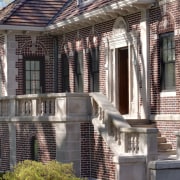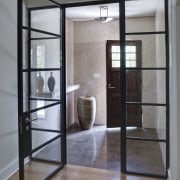In the frame
In the frame classic house with modern insertions
When it comes to traditional house remodels there can often be a design disconnect. Owners may fall for a grand historic exterior, but are less fond of the claustrophobic rooms and poorly oriented living spaces that are hallmarks of architectural times gone by.
This was the scenario for the owners of a 1920s residence remodeled by architect William Massey. The owners loved the grand lines of the house, and the brick and limestone facade, but not so much the dark, cramped interiors.
"In terms of exterior work, the facades were repointed and the house expanded with a new open porch and pergola at the rear and a new deck off the upstairs master suite," says Massey. "However, on the inside, the remodeling was comprehensive with all three levels reworked. New spaces were added to the underused basement, including a gymnasium, games room and media room. However this project is more about the first and second floors, which were extensively updated.
"Remodeling issues with older interiors are often about light and space. The formal rooms traditionally looked to the front of a home but suffered from poor connections to the rear."
"Interiors were often cluttered and clogged by an excess of small ancillary spaces," says Massey. "Moving around was time consuming and natural light often could not penetrate and flow through the generous public spaces."

To address these issues on the first floor, the architect stripped out a central bathroom and several closets. In their place, a stair and rear hall improve pedestrian connections and light flow. The living room, sitting room and dining area remain in the same place, but the connections between these spaces have been improved, creating vistas through the home and further enhancing light penetration.
The kitchen was moved to the other side of the house, replacing the master bedroom which is now in the former second-floor attic. A breakfast room and sunny laundry were added at the rear corners, replacing a sunroom and mud room. The hallway between these rooms leads to the new covered porch, creating a seamless connection to the rear yard.
Upstairs, another bedroom and the master suite were added. The new master bedroom opens to a deck that had been a roof. This was achieved by removing a gable window, expanding the opening and introducing French doors in its place. Rooms at this level were set back beneath the roofline, where possible, to optimize room heights one owner is quite tall.
"In terms of the interior look, we began by stripping all the original wall plaster, which had sagged over time, and swapped out the existing dark oak window surrounds," says Massey. "The mouldings and baseboards were replaced with standard traditional forms that suited the house but were not as oppressive visually. Large dark beams in the dining room were also taken out, greatly lightening the space."
"The entry hall's porcelain floors and marble walls create a sense of arrival that's in keeping with the exterior," says Massey. "And it is right from the front entry that you are greeted by a key accent in this design two contemporary, industrial-look steel and glass freestanding walls. The screen at the entry is repeated at the edge of the adjacent dining area, as a divider from the hallway."

The elements are transparent, so they don't affect issues of visual space or light penetration
Massey says one owner owns a factory and wanted a little of its strong, simple aesthetic to inform and bring a sense of crisp modernity to the serene traditional spaces.
The house has another less obvious modern inclusion. It has achieved the enviable merit of a Silver LEED project. The fact that the ratio of bedroom numbers to overall floor space was relatively low tipped by the upgrade of the basement had made this harder to achieve.
"There was no room for solar panels, but everything else has been addressed," says Massey. "Aspects included reusing existing building materials, minimizing construction waste, and specifying water-sense plumbing. Natural ventilation was optimized and there is a new high-tech heat recovery air conditioning system. All paints and finishes are low VOC. Outdoors, efficient site irrigation and the choice of local plantings also contributed to the home's eco-friendly rating."
The reinvented home is warm and filled with light the rear hall, repositioned kitchen and corner breakfast room open the house to the rear yard, as does the new covered porch. The spaces are simpler and more user friendly, and the new master suite includes a private deck looking out to landscaped views.
Story by: Charles Moxham
Home kitchen bathroom commercial design
US Home & Architectural Trends Vol. 30/5
Home & Architecture Trends highlights great residential architecture. This book provides prospective home builders a...
Read More













